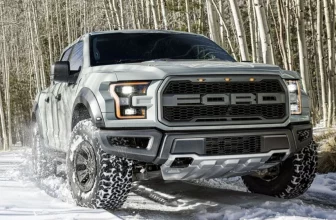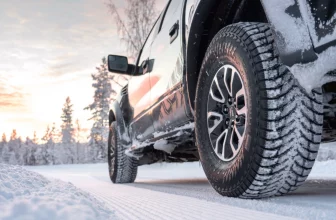What does the 3-peak mountain snowflake (3PMSF) symbol mean on your tires? Does this symbol have any implications on the performance of the tire? How far can you go on these tires? Winter driving is undoubtedly one of the most challenging experiences that renders standard tires unsuitable. Enjoying a safe winter ride demands that you find an efficient set of tires. The best bet is the performance winter tires.
There are a few things that define driving experiences. They are traction, easy handling and efficient braking. In winter, a slight drop in any of these performance characteristics spells doom when it comes to safety. In reality, very few tires can guarantee efficiency in winter. The freezing temperatures stiffen rubber material, and it becomes a bumpy ride all the way.
How do you go selecting the right set of tires for winter driving? What are some features that you should look for when purchasing your tires? This informative article highlights all the specifics, evaluates the reliability of performance winter tires and provides recommendations on their applicability. Cold weather, snow and ice on the roads should not be a reason for you not to drive.
| Tire name | Best in Category | Winter/snow performance | Steering response | Wet performance | Hydroplaning resistance | Wet traction | Dry performance | Cornering stability | Dry traction | Comfort performance | Ride quality | Noise score | Treadwear performance |
|---|---|---|---|---|---|---|---|---|---|---|---|---|---|
| Bridgestone Blizzak WS90 | 100% | 9.3 | 8.4 | 9 | 9.1 | 8.9 | 8.6 | 8.4 | 8.9 | 8.8 | 9.2 | 8.3 | 8.4 |
| Michelin X-Ice Xi3 | 100% | 8.8 | 8.4 | 8.8 | 8.8 | 8.8 | 8.5 | 8.4 | 8.8 | 8.9 | 9.1 | 8.7 | 9 |
| Bridgestone Blizzak LM-50 RFT | 100% | 8.8 | 8.6 | 8.8 | 8.7 | 9 | 8.6 | 8.3 | 9 | 7.7 | 8 | 7.4 | 6.6 |
| Continental VikingContact 7 | 99% | 8.8 | 8.3 | 8.7 | 8.7 | 8.8 | 8.5 | 8.5 | 8.6 | 9.2 | 9.3 | 9.1 | 8.6 |
| Goodyear Ultra Grip Ice WRT | 97% | 8.7 | 8.2 | 8.8 | 8.8 | 8.8 | 8.4 | 8.3 | 8.6 | 8.1 | 8.4 | 7.8 | 8.7 |
| Yokohama iceGUARD iG52c | 92% | 8.7 | 7.7 | 7.8 | 8.1 | 7.5 | 7.7 | 7.7 | 7.8 | 8.1 | 8.6 | 7.6 | 8.3 |
| Yokohama iceGUARD iG20 | 90% | 8.6 | 6.9 | 8.1 | 8.2 | 7.9 | 6.9 | 6.9 | 6.8 | 7.8 | 8.3 | 7.4 | 8 |
What sets performance winter tires apart?
Performance winter tires are available in diverse speed ratings and sizes. There is a size for sedans, coupes, SUVs, CUVs, light trucks and pickups. One notable feature is the 3PMSF symbol which signifies compliance to strict testing conditions.
Heavy siping
The last thing a driving enthusiast wants is getting stuck or difficulty accelerating on slushy or snowy roads. Snow gets stuck between treads impeding motion. Drivers struggle to steer the vehicle or even bring it to a stop after a momentary acceleration. Performance winter tires have full-depth sipes to bite into the snow.
As the treads dig into the snow, the sipes bite on the loosely packed surface and eject snow so that tires maintain a grip on the road. Sipes are vital for the creation of snow-to-snow traction. The heavy sipes enhance driving experiences in medium to deep snow and icy roads. Drivers can cruise at high speed without worrying over the responsiveness of the tires to braking or cornering.
Stiff center blocks
Maximizing wet traction is a priority when it comes to driving on performance winter tires. For predictable driving, the tires must maintain a substantive footprint or contact patch with the road surface. Tire manufacturers adopt designs with stiff center blocks. They improve the traction capabilities of the tires, enabling them to navigate snowy or icy roads.
Flexible rubber material
Ordinary tire rubber hardens and deforms at freezing temperature. At freezing temperatures, the tires are unresponsive. Like any other tire challenge, manufacturers are continually experimenting with advanced materials to produce the most flexible tire that can combat the harsh winter climate. A popular technique is using flexible rubber materials and a blend of additives that enhance traction and resistance to deformation.
Tread patterns
Performance winter tires have different tread patterns ranging from directional to asymmetric. Each manufacturer optimizes these patterns with traction efficiencies in mind. At the very basic, the tread patterns ensure sufficient traction at any angle.
They also maximize the effective biting edges so that drivers can attain optimum control over the vehicle. Tread patterns are significant for controlling road noises. That way, the quality of the ride remains modest even at high-speed driving over snow.
Deep grooves
Vehicles risk hydroplaning when driving on wet roads. These roads are slippery and cause steering problems. Fortunately, performance winter tires have an adequate defense against hydroplaning.
They have deep circumferential and lateral grooves. They cut deeply into the tire. As the vehicle accelerates, the grooves expel water underneath the tire, maximizing the contact patch with the road for ultimate wet traction.
Pros & Cons of performance winter tires
How do Performance Winter Tires Compare to Other Categories?
As the name implies, the applicability of these tires is limited. Anything outside winter usage leads to an enormous drop in their performance. That said, these tires provide remarkable dry traction, which rivals that of non-specialized ordinary tires.
Performance winter tires use a soft, flexible rubber material. As such, they crumble under the summer heat. The tires will wear out faster, with the tires shedding off some traction. You should not use these tires for summer driving. Instead, use specialized performance summer tires or performance all-season tires.
Off-roads are a no-go zone when driving on performance winter tires. They are generally soft and susceptible to puncturing, abrasion and cuts. If you spend the most time away from the highway, consider purchasing a set of all-terrain tires.
Studded winter tires will perform better than performance winter tires. They can cut through deep snow and thick ice with ease. By comparison, performance winter tires are easy to handle than the former.
Verdict
These tires are a perfect choice for drivers that commute in areas that experience frequent snowfall. They inspire the confidence required when traversing the usually unpredictable roads. These tires balance driving comfort, safety and responsive handling. When shopping for performance winter tires, pay attention to speed ratings and the snowflake symbol.
Frequently asked questions
How do I choose the correct performance tire for winter?
Preferences vary for every driver. But as a guiding principle, understand the quantity of snow that you have to wade through. Check the tread patterns to identify if it has sufficient sipes. Choose a whose speed ratings match your speed expectations with a befitting load-bearing capacity.
When should I change my performance winter tires?
Tires with 5/32” tread depth and above are safe for use in wintry conditions. That, however, does not guarantee driving safety. Inflate your tires properly to avoid steering and handling problems. Remember that the traction capabilities of these tires vary significantly.






